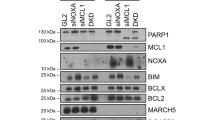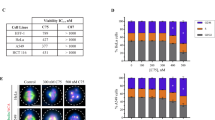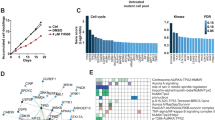Abstract
Microtubule-perturbing drugs have become front-line chemotherapeutics, inducing cell-cycle crisis as a major mechanism of action. However, these agents show pleiotropic effects on cells and can induce apoptosis through other means. Paclitaxel, a microtubule-stabilizing agent, induces a caspase-dependent apoptosis, although the precise mechanism(s) remain unclear. Here, we used genetic approaches to evaluate the role of caspase 8 in paclitaxel-mediated apoptosis. We observed that caspase 8-expressing cells are more sensitive to paclitaxel than caspase 8-deficient cells. Mechanistically, caspase 8 was found associated with microtubules, and this interaction increased after paclitaxel treatment. The prodomains death effector domains (DEDs) of caspase 8 were sufficient for interaction with microtubules, but the caspase 8 holoprotein was required for apoptosis. DED-only forms of caspase 8 were found in both primary and tumor cell lines, associating with perinuclear microtubules and the centrosome. Microtubule association, and paclitaxel sensitivity, depends on a critical lysine (K156) within a microtubule-binding motif (KLD) in DED-b of caspase 8. The results show an unexpected pathway of apoptosis mediated by caspase 8.
This is a preview of subscription content, access via your institution
Access options
Subscribe to this journal
Receive 50 print issues and online access
$259.00 per year
only $5.18 per issue
Buy this article
- Purchase on Springer Link
- Instant access to full article PDF
Prices may be subject to local taxes which are calculated during checkout







Similar content being viewed by others
References
Al-Bassam J, Cui Y, Klopfenstein D, Carragher BO, Vale RD, Milligan RA . (2003). Distinct conformations of the kinesin Unc104 neck regulate a monomer to dimer motor transition. J Cell Biol 163: 743–753.
Al-Bassam J, Ozer RS, Safer D, Halpain S, Milligan RA . (2002). MAP2 and tau bind longitudinally along the outer ridges of microtubule protofilaments. J Cell Biol 157: 1187–1196.
Barbero S, Barila D, Mielgo A, Stagni V, Clair K, Stupack D . (2008). Identification of a critical tyrosine residue in caspase 8 that promotes cell migration. J Biol Chem 283: 13031–13034.
Barnhart BC, Lee JC, Alappat EC, Peter ME . (2003). The death effector domain protein family. Oncogene 22: 8634–8644.
Bayless KJ, Davis GE . (2004). Microtubule depolymerization rapidly collapses capillary tube networks in vitro and angiogenic vessels in vivo through the small GTPase Rho. J Biol Chem 279: 11686–11695.
Beisner DR, Chu IH, Arechiga AF, Hedrick SM, Walsh CM . (2003). The requirements for Fas-associated death domain signaling in mature T cell activation and survival. J Immunol 171: 247–256.
Blaineau C, Tessier M, Dubessay P, Tasse L, Crobu L, Pages M et al. (2007). A novel microtubule-depolymerizing kinesin involved in length control of a eukaryotic flagellum. Curr Biol 17: 778–782.
Boatright KM, Renatus M, Scott FL, Sperandio S, Shin H, Pedersen IM et al. (2003). A unified model for apical caspase activation. Mol Cell 11: 529–541.
Bornens M, Paintrand M, Berges J, Marty MC, Karsenti E . (1987). Structural and chemical characterization of isolated centrosomes. Cell Motil Cytoskeleton 8: 238–249.
Calvaruso G, Giuliano M, Portanova P, De Blasio A, Vento R, Tesoriere G . (2006). Bortezomib induces in HepG2 cells IkappaBalpha degradation mediated by caspase-8. Mol Cell Biochem 287: 13–19.
Carrington PE, Sandu C, Wei Y, Hill JM, Morisawa G, Huang T et al. (2006). The structure of FADD and its mode of interaction with procaspase-8. Mol Cell 22: 599–610.
Chauhan D, Singh A, Brahmandam M, Podar K, Hideshima T, Richardson P et al. (2008). Combination of proteasome inhibitors bortezomib and NPI-0052 trigger in vivo synergistic cytotoxicity in multiple myeloma. Blood 111: 1654–1664.
Feng G, Kaplowitz N . (2000). Colchicine protects mice from the lethal effect of an agonistic anti-Fas antibody. J Clin Invest 105: 329–339.
Garvey T, Bertin J, Siegel R, Lenardo M, Cohen J . (2002a). The death effector domains (DEDs) of the molluscum contagiosum virus MC159 v-FLIP protein are not functionally interchangeable with each other or with the DEDs of caspase-8. Virology 300: 217–225.
Garvey TL, Bertin J, Siegel RM, Wang GH, Lenardo MJ, Cohen JI . (2002b). Binding of FADD and caspase-8 to molluscum contagiosum virus MC159 v-FLIP is not sufficient for its antiapoptotic function. J Virol 76: 697–706.
Gascoigne KE, Taylor SS . (2008). Cancer cells display profound intra-and interline variation following prolonged exposure to antimitotic drugs. Cancer Cell 14: 111–122.
Gdynia G, Grund K, Eckert A, Bock BC, Funke B, Macher-Goeppinger S et al. (2007). Basal caspase activity promotes migration and invasiveness in glioblastoma cells. Mol Cancer Res 5: 1232–1240.
Goode BL, Feinstein SC . (1994). Identification of a novel microtubule binding and assembly domain in the developmentally regulated inter-repeat region of tau. J Cell Biol 124: 769–782.
Hetz CA, Hunn M, Rojas P, Torres V, Leyton L, Quest AF . (2002). Caspase-dependent initiation of apoptosis and necrosis by the Fas receptor in lymphoid cells: onset of necrosis is associated with delayed ceramide increase. J Cell Sci 115: 4671–4683.
Kabore AF, Sun J, Hu X, McCrea K, Johnston JB, Gibson SB . (2006). The TRAIL apoptotic pathway mediates proteasome inhibitor induced apoptosis in primary chronic lymphocytic leukemia cells. Apoptosis 11: 1175–1193.
Kasibhatla S, Baichwal V, Cai SX, Roth B, Skvortsova I, Skvortsov S et al. (2007). MPC-6827: a small-molecule inhibitor of microtubule formation that is not a substrate for multidrug resistance pumps. Cancer Res 67: 5865–5871.
Kennedy NJ, Kataoka T, Tschopp J, Budd RC . (1999). Caspase activation is required for T cell proliferation. J Exp Med 190: 1891–1896.
Kretschmar CS, Kletzel M, Murray K, Thorner P, Joshi V, Marcus R et al. (2004). Response to paclitaxel, topotecan, and topotecan-cyclophosphamide in children with untreated disseminated neuroblastoma treated in an upfront phase II investigational window: a pediatric oncology group study. J Clin Oncol 22: 4119–4126.
Kim M, Liao J, Dowling ML, Voong KR, Parker SE, Wang S et al. (2008). TRAIL inactivates the mitotic checkpoint and potentiates death induced by microtubule-targeting agents in human cancer cells. Cancer Res 68: 3440–3449.
McDonald ER, El-Deiry WS . (2004). Suppression of caspase-8- and -10-associated RING proteins results in sensitization to death ligands and inhibition of tumor cell growth. Proc Natl Acad Sci USA 101: 6170–6175.
Medema JP, Scaffidi C, Kischkel FC, Shevchenko A, Mann M, Krammer PH et al. (1997). FLICE is activated by association with the CD95 death-inducing signaling complex (DISC). EMBO J 16: 2794–2804.
Miller CP, Ban K, Dujka ME, McConkey DJ, Munsell M, Palladino M et al. (2007). NPI-0052, a novel proteasome inhibitor, induces caspase-8 and ROS-dependent apoptosis alone and in combination with HDAC inhibitors in leukemia cells. Blood 110: 267–277.
Mitsui C, Sakai K, Ninomiya T, Koike T . (2001). Involvement of TLCK-sensitive serine protease in colchicine-induced cell death of sympathetic neurons in culture. J Neurosci Res 66: 601–611.
Nimmanapalli R, Perkins CL, Orlando M, O'Bryan E, Nguyen D, Bhalla KN . (2001). Pretreatment with paclitaxel enhances apo-2 ligand/tumor necrosis factor-related apoptosis-inducing ligand-induced apoptosis of prostate cancer cells by inducing death receptors 4 and 5 protein levels. Cancer Res 61: 759–763.
Odoux C, Albers A . (2004). Additive effects of TRAIL and paclitaxel on cancer cells: implications for advances in cancer therapy. Vitam Horm 67: 385–407.
Odoux C, Albers A, Amoscato AA, Lotze MT, Wong MK . (2002). TRAIL, FasL and a blocking anti-DR5 antibody augment paclitaxel-induced apoptosis in human non-small-cell lung cancer. Int J Cancer 97: 458–465.
Ogawa T, Nitta R, Okada Y, Hirokawa N . (2004). A common mechanism for microtubule destabilizers-M type kinesins stabilize curling of the protofilament using the class-specific neck and loops. Cell 116: 591–602.
Park SJ, Wu CH, Gordon JD, Zhong X, Emami A, Safa AR . (2004). Taxol induces caspase-10-dependent apoptosis. J Biol Chem 279: 51057–51067.
Pellegrini M, Bath S, Marsden VS, Huang DC, Metcalf D, Harris AW et al. (2005). FADD and caspase-8 are required for cytokine-induced proliferation of hemopoietic progenitor cells. Blood 106: 1581–1589.
Petit I, Karajannis MA, Vincent L, Young L, Butler J, Hooper AT et al. (2008). The microtubule-targeting agent CA4P regresses leukemic xenografts by disrupting interaction with vascular cells and mitochondrial-dependent cell death. Blood 111: 1951–1961.
Rozman-Pungercar J, Kopitar-Jerala N, Bogyo M, Turk D, Vasiljeva O, Stefe I et al. (2003). Inhibition of papain-like cysteine proteases and legumain by caspase-specific inhibitors: when reaction mechanism is more important than specificity. Cell Death Differ 10: 881–888.
Scaffidi C, Medema JP, Krammer PH, Peter ME . (1997). FLICE is predominantly expressed as two functionally active isoforms, caspase-8/a and caspase-8/b. J Biol Chem 272: 26953–26958.
Schneider-Brachert W, Tchikov V, Neumeyer J, Jakob M, Winoto-Morbach S, Held-Feindt J et al. (2004). Compartmentalization of TNF receptor 1 signaling: internalized TNF receptosomes as death signaling vesicles. Immunity 21: 415–428.
Shikama Y, Shen L, Yonetani M, Miyauchi J, Miyashita T, Yamada M . (2002). Death effector domain-only polypeptides of caspase-8 and -10 specifically inhibit death receptor-induced cell death. Biochem Biophys Res Commun 291: 484–493.
Siegel RM, Martin DA, Zheng L, Ng SY, Bertin J, Cohen J et al. (1998). Death-effector filaments: novel cytoplasmic structures that recruit caspases and trigger apoptosis. J Cell Biol 141: 1243–1253.
Singh TR, Shankar S, Chen X, Asim M, Srivastava RK . (2003). Synergistic interactions of chemotherapeutic drugs and tumor necrosis factor-related apoptosis-inducing ligand/Apo-2 ligand on apoptosis and on regression of breast carcinoma in vivo. Cancer Res 63: 5390–5400.
Stupack DG, Puente XS, Boutsaboualoy S, Storgard CM, Cheresh DA . (2001). Apoptosis of adherent cells by recruitment of caspase-8 to unligated integrins. J Cell Biol 155: 459–470.
Stupack DG, Teitz T, Potter MD, Mikolon D, Houghton PJ, Kidd VJ et al. (2006). Potentiation of neuroblastoma metastasis by loss of caspase-8. Nature 439: 95–99.
Su H, Bidere N, Zheng L, Cubre A, Sakai K, Dale J et al. (2005). Requirement for caspase-8 in NF-kappaB activation by antigen receptor. Science 307: 1465–1468.
Tang MJ, Tai IT . (2007). A novel interaction between procaspase 8 and SPARC enhances apoptosis and potentiates chemotherapy sensitivity in colorectal cancers. J Biol Chem 282: 34457–34467.
Teitz T, Lahti JM, Kidd VJ . (2001). Aggressive childhood neuroblastomas do not express caspase-8: an important component of programmed cell death. J Mol Med 79: 428–436.
Teitz T, Wei T, Liu D, Valentine V, Valentine M, Grenet J et al. (2002). Caspase-9 and Apaf-1 are expressed and functionally active in human neuroblastoma tumor cell lines with 1p36 LOH and amplified MYCN. Oncogene 21: 1848–1858.
Tibbetts MD, Zheng L, Lenardo MJ . (2003). The death effector domain protein family: regulators of cellular homeostasis. Nat Immunol 4: 404–409.
Torres VA, Mielgo A, Barila D, Anderson DH, Stupack D . (2008). Caspase 8 promotes peripheral localization and activation of Rab5. J Biol Chem 283: 36280–36289.
von Haefen C, Wieder T, Essmann F, Schulze-Osthoff K, Dorken B, Daniel PT . (2003). Paclitaxel-induced apoptosis in BJAB cells proceeds via a death receptor-independent, caspases-3/-8-driven mitochondrial amplification loop. Oncogene 22: 2236–2247.
Voortman J, Resende TP, Abou El Hassan MA, Giaccone G, Kruyt FA . (2007). TRAIL therapy in non-small cell lung cancer cells: sensitization to death receptor-mediated apoptosis by proteasome inhibitor bortezomib. Mol Cancer Ther 6: 2103–2112.
Weber CH, Vincenz C . (2001). The death domain superfamily: a tale of two interfaces? Trends Biochem Sci 26: 475–481.
Wieder T, Essmann F, Prokop A, Schmelz K, Schulze-Osthoff K, Beyaert R et al. (2001). Activation of caspase-8 in drug-induced apoptosis of B-lymphoid cells is independent of CD95/Fas receptor–ligand interaction and occurs downstream of caspase-3. Blood 97: 1378–1387.
Yao Z, Duan S, Hou D, Heese K, Wu M . (2007). Death effector domain DEDa, a self-cleaved product of caspase-8/Mch5, translocates to the nucleus by binding to ERK1/2 and upregulates procaspase-8 expression via a p53-dependent mechanism. EMBO J 26: 1068–1080.
Zhu H, Zhang L, Huang X, Davis JJ, Jacob DA, Teraishi F et al. (2004). Overcoming acquired resistance to TRAIL by chemotherapeutic agents and calpain inhibitor I through distinct mechanisms. Mol Ther 9: 666–673.
Acknowledgements
This work was supported by the NIH/NCI Grant CA107263 to DGS and by grants from the Swiss National Foundation, the Novartis Foundation and the Caja Madrid Foundation to AM. The authors thank Drs S Zeitlin and M Hogan for helpful comments and Drs Marcus Peter (Ben May Institute), Jill Lahti (St Jude Children's Research Hospital), Mark Ginsberg (UCSD) and Guy Salvesen (The Burnham Institute) for the kind gift of reagents.
Author information
Authors and Affiliations
Corresponding author
Additional information
Supplementary Information accompanies the paper on the Oncogene website (http://www.nature.com/onc)
Supplementary information
Rights and permissions
About this article
Cite this article
Mielgo, A., Torres, V., Clair, K. et al. Paclitaxel promotes a caspase 8-mediated apoptosis through death effector domain association with microtubules. Oncogene 28, 3551–3562 (2009). https://doi.org/10.1038/onc.2009.210
Received:
Revised:
Accepted:
Published:
Issue Date:
DOI: https://doi.org/10.1038/onc.2009.210
Keywords
This article is cited by
-
Clinical and microarray analysis of breast cancers of all subtypes from two prospective preoperative chemotherapy studies
British Journal of Cancer (2016)
-
Effects of paclitaxel on permanent head and neck squamous cell carcinoma cell lines and identification of anti-apoptotic caspase 9b
Journal of Cancer Research and Clinical Oncology (2016)
-
Cratoxylum formosum (Jack) Dyer ssp. pruniflorum (Kurz) Gogel. (Hóng yá mù) extract induces apoptosis in human hepatocellular carcinoma HepG2 cells through caspase-dependent pathways
Chinese Medicine (2014)
-
BRCA1 regulates microtubule dynamics and taxane-induced apoptotic cell signaling
Oncogene (2014)
-
Caspase-8 isoform 6 promotes death effector filament formation independent of microtubules
Apoptosis (2012)



